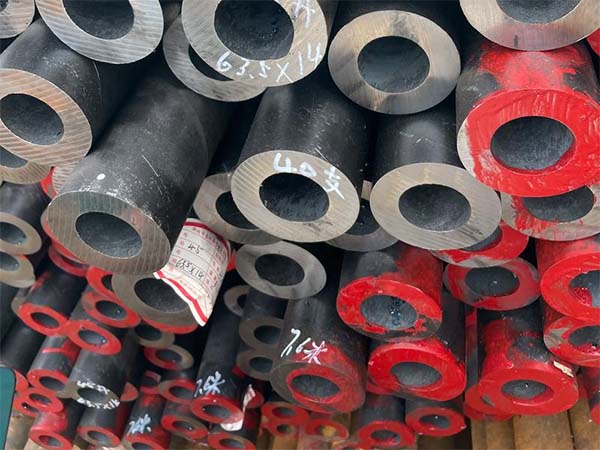The main differences between
alloy seamless steel pipes and
carbon seamless steel pipes lie in aspects such as composition, process, performance, and application. The following is a detailed comparison of these two types of steel pipes for everyone.
Alloy seamless steel pipes achieve higher strength, high-temperature resistance and corrosion resistance by adding alloying elements such as chromium, nickel and molybdenum to steel and combining with special heat treatment processes. Carbon steel seamless pipes, with carbon as the main alloying element, have the advantages of low cost, good processability, and suitability for general medium and low-pressure transportation and structural support. However, their performance is somewhat limited in extremely high-temperature, high-pressure or highly corrosive environments.

The differences in chemical composition
Alloy steel pipe
By adding one or more alloying elements (such as Cr, Mo, Ni, V, Nb, Ti, etc.) to the base steel, these alloying elements can endow the steel pipe with higher strength and make it have properties such as high-temperature resistance, corrosion resistance and wear resistance. The element content is 0.5% - 12% for Cr, 0.2% - 2.0% for Mo, 2% - 30% for Ni, etc.
Carbon steel pipe
Carbon steel pipes are mainly composed of iron and carbon, with a carbon content typically ranging from 0.04% to 0.25%. No other alloying elements are deliberately added, and a small amount of silicon and manganese can be added as deoxidizers. Seamless steel tubes can be classified into low-carbon steel, medium-carbon steel and high-carbon steel according to carbon content and application.
Differences in mechanical properties
Alloy steel pipe
Alloy steel pipes, due to the presence of alloying elements, possess higher strength, corrosion resistance, wear resistance and high-temperature resistance, and can maintain excellent performance under extreme conditions. The yield strength can be ≥ 300 MPa, and the tensile strength range can reach 550-1000 MPa or higher, depending on the alloy grade.
Carbon steel pipe
Carbon steel pipes can be classified into low-carbon steel pipes, medium-carbon steel pipes and high-carbon steel pipes based on their carbon content. As the carbon content increases, the hardness of the steel pipe becomes higher, but its ductility decreases. Low-carbon steel pipes are more commonly used. The yield strength is usually about 235-355 MPa, and the tensile strength is about 370-600 MPa (taking ASTM A106/A53 or API 5L X series as examples). It has good ductility, with a typical elongation rate of 10% to 25%.
Comparison of corrosion resistance and heat resistance
Alloy steel pipe
It contains elements such as chromium, nickel and molybdenum, which can form a stable oxide film and has strong corrosion resistance. It can withstand high-temperature environments (for example, chromium-molybdenum steel can withstand temperatures exceeding 600 ℃), and has better thermal stability.
Carbon steel pipe
The surface is prone to rust and has poor corrosion resistance, usually requiring protective treatments such as coating and galvanizing. The heat resistance is limited, and the upper limit for long-term use is approximately 350 ℃.
The differences in manufacturing processes
Alloy steel seamless pipe
Production control is strict. Raw materials need to be precisely proportioning. The manufacturing process includes hot rolling/cold drawing, complex heat treatment (quenching + tempering, solution treatment, etc.).
Carbon steel seamless pipe
The process is relatively simple, with hot rolling and piercing forming, and occasionally size adjustment through cold rolling/cold drawing. Heat treatment is also relatively simple, usually normalizing or annealing.
The differences in application fields
Alloy steel seamless pipe
Due to the strong mechanical properties of alloy steel, it is widely used in industries that require high performance, such as
High temperature and high pressure: Chemical industry, petroleum cracking, boilers, steam turbines
Corrosion-resistant applications: Offshore platforms, acid and alkali process pipelines
Wear-resistant applications: Mines, sand mining and conveying pipelines
Carbon steel seamless pipe
Carbon steel seamless pipes have the characteristics of easy processing and low cost, and are suitable for some medium and low-demand industries, such as:
Low-pressure transportation: water, steam and gas pipelines
Structural pipes: Bridges, scaffolding, mechanical pillars
Summary
If used for general structures and medium and low pressure transportation, carbon steel seamless pipes have the advantages of low cost and easy processing.
For high-temperature, high-pressure, highly corrosive or high-wear environments, alloy seamless steel pipes can achieve higher strength, toughness and environmental resistance by adjusting the alloy composition and heat treatment.
Read more : Manufacturing process of alloy steel pipes
